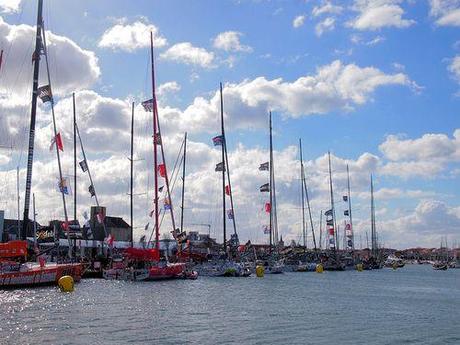
I'd never heard of the Vendée Globe before I came to France. When I starting hearing the name on the radio, I thought it was Vent des Globes and couldn't figure out what they were talking about. But I listened to Radio France Info a lot because I was driving around Paris and it was very handy for learning who was on strike or demonstrating and it improved my French. That's when I got hooked on the Vendée Globe. This year's race started on Saturday.
The Vendée Globe is a singlehanded, round-the-world sailing race, 24,000 kilometers long (almost 15,000 miles). It leaves from and returns to the Sables d'Olonne in the Vendée, south of Brittany, and attracts the best sailors in the world. Because sailing is a very French sport, and many of the top sailors in the world are French, the race receives breathless, day-by-day coverage in the French media. Since it began in 1989, every winner has been French.
And sometimes the stories are so dramatic you get caught up in it. The 1996 race was like that. It had the usual full cast of interesting characters, including Isabelle Autissier, at the time the most famous woman sailor in the world.
In the Southern Ocean, the race's route goes more than a thousand miles south of Australia and New Zealand, through some of the stormiest and loneliest places on the planet. There, in the 1996 race, a storm hit and many of the sailors began to struggle. Isabelle Autissier broke a rudder and had to quit the race. The Australian navy rescued two capsized competitors. Another, Raphael Dinelli, a "pirate" who had joined the race too late to qualify, almost died when his boat capsized. The Australians managed to drop a life raft down to him from a plane, but the seas and winds were icy and he could not survive long in the open raft. British racer Pete Goss turned back, thereby renouncing winning the race, and spent two days risking his own life sailing into gale-force winds to save Dinelli's life. (He later won a Legion of Honor and an MBE for this.)
Two sailors vanished: British Tony Bullimore and Canadian Gerry Roufs. For days, I listened anxiously to the radio hoping to hear news of them. Tony Bullimore's boat was spotted by an Australian plane, upside down. An Australian navy ship headed toward him but was four days away. A sailing expert said that it was just barely possible that Bullimore could survive inside the overturned hull. I remember thinking, "Yeah, sure." When the Australian ship reached the small, capsized boat, they took a motorized raft over to it and one of them knocked on the hull. To their joy and amazement, a knock answered them. A few seconds later, Bullimore swam out. You can see a photo of that moment here. Bullimore had spent five days in pitch blackness underneath the boat only a few inches above stormy seas, thousands of miles from help and not knowing if anyone would ever come. And he survived! It was one of those happy moments where things turn out so much better than expected, what J.R.R. Tolkien called a eucatastrophe.
Gerry Roufs, though, was never found. Five months later, his boat washed up on the shores of Chile.

